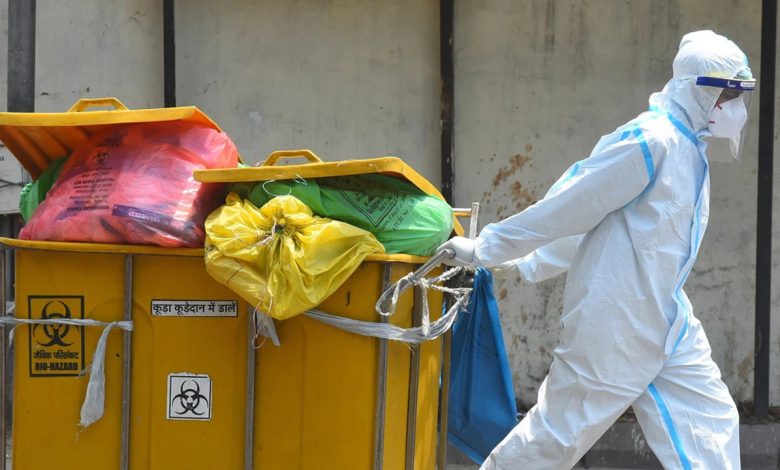Biomedical Waste Management Rules across India
[GS Paper 3 - Environmental Pollution and Degradation]

Context – The National Green Tribunal has pointed out a huge lack of compliance of biomedical waste management rules across the country.
The tribunal has asked for the implementation of the framework which emphasizes strict adherence to the norms related to the maintenance, storage and movement of Biomedical Waste Treatment.
What is Biomedical Waste?
- Biomedical or Hospital Waste is any kind of waste containing infectious materials. It may also include waste associated with the generation of biomedical waste that visually appears to be medical.
- Broadly, Biomedical Waste refers to any waste which is generated during the diagnosis, treatment or immunization of human beings or animals or in research activities pertaining thereto or in production or testing of biological products including categories mentioned in Schedule 1, of the BMW Rules 2016.
- The Biomedical Wastes consist of:
- Human anatomical waste like tissues, organs and body parts
- Animal wastes generated during research from veterinary hospitals
- Microbiology and biotechnology wastes
- Waste sharps like hypodermic needles, syringes, scalpels and broken glass
- Discarded medicines and cytotoxic drugs
- Soiled waste such as dressing, bandages, plaster casts, material contaminated with blood, tubes and catheters
- Liquid waste from any of the infected areas
- Incineration ash and other chemical wastes
Treatment of Biomedical Waste in India

- Autoclaving – The process of autoclaving involves steam sterilization. Instead of incineration, which can be expensive, autoclaving simply introduces very hot steam for a determined amount of time.
- Incineration – The major benefits of incineration are that it is quick, easy, and simple. It effectively removes the waste entirely and safely removes any microorganisms.
- Chemical disinfection – When it comes to liquid waste, a common biomedical waste disposal method can be chemical disinfection. Chlorine is a regular choice for this process, and is introduced to the liquid waste in order to kill microorganisms and pathogens.
- Microwaving – Microwave technology can also disinfect wastes. Wastes are first placed into a shredder. This wastes are mixed with water and internally heated that neutralizes present biologicals.
- Irradiation – This method involves waste sterilization by exposing waste to cobalt sources. Cobalt emits gamma rays that kill all the microbes in wastes.
- Shredding – It is a process by which waste are deshaped or cut into smaller pieces so as to make the wastes unrecognizable. It helps in prevention of reuse of bio-medical waste and also acts as an identifier that the wastes have been disinfected and are safe to dispose-off.
Authorities Dealing with Biomedical Waste in India
- Central Pollution Control Board – The CPCB has been following up with all SPCBs/PCCs to ensure effective management of biomedical waste in States/UTs.
- National Green Tribunal (NGT) – The NGT has been stringent on the application of the BMW 2016.
- Common Bio-Medical Waste Treatment and Disposal Facilities (CBWTDF) – There are now over 200 licensed CBWTDF or Common Treatment Facilities (CTF) in India.
Features of BMW, 2016
- Compulsory pre-treatment – The method of sterilization/disinfection should be in accordance with National AIDS Control Organization (NACO) or WHO.
- Phasing out plastic use – The use of chlorinated plastic bags, gloves, blood bags, etc. should be gradually stopped and this phasing out should be within 2 years from the date of notification of these rules.
- Safe disposal of Liquid waste – They need to be separated at source by pre-treatment before mixing with other liquid waste.
- Incineration guidelines – The existing incinerator should be upgraded/modified to achieve the new standard within 2 years from the date of this notification.
Color Coding of Biomedical Waste in India
As per Bio-medical Waste Management Rules, 2016, Bio-medical waste is required to be segregated in following color coded waste categories –
- Red Bag – Syringes (without needles), soiled gloves, catheters, IV tubes etc. should be all disposed of in a red coloured bag, which will later be incinerated.
- Yellow Bag – All dressings, bandages and cotton swabs with body fluids, blood bags, human anatomical waste, body parts are to be discarded in yellow bags.
- Cardboard box with blue marking – Glass vials, ampules, other glassware is to be discarded in a cardboard box with a blue marking/sticker.
- White Puncture Proof Container (PPC) – Needles, sharps, blades are disposed of in a white translucent puncture proof container.
- Black Bags – These are to be used for non-bio-medical waste. In a hospital setup, this includes stationary, vegetable and fruit peels, leftovers, packaging including that from medicines, disposable caps, disposable masks, disposable shoe-covers, disposable tea cups, cartons, sweeping dust, kitchen waste etc.
Concerns with Biomedical Waste
- Land Pollution – If not treated and dumped into landfills then there is a high chance for heavy metals like cadmium, lead, mercury, etc. get released. Further, there is a chance these metals get absorbed by plants and can then enter the food chain also.
- Air Pollution – Pathogens present in the waste can enter and remain in the air for a long period in the form of spores or pathogens. As Covid-19 spreads through the air, improper treating/not treating it might lead to a new wave of respiratory syndromes.
- Radioactive Pollution – Hospitals are increasingly using radioactive isotopes for diagnostic and therapeutic applications. The main radioisotopes used in hospitals are technetium-99m (Tc-99m), Iodine-131(I-131), etc. These have carcinogenic properties.
- Epidemic – According to the WHO study, improper waste management is one of the major causes of an increase in infectious diseases globally. This is why the Covid-19 pandemic wastes require proper treatment.
- Operational Health Hazards – Improper handling of biomedical waste might lead to Injuries from sharps and exposure to harmful radioactive wastes. This will create issues for nurses, emergency medical personnel, and sanitary workers.
- Increased Antimicrobial Resistance (AMR) – Biomedical wastes aggravate the problem of AMR. Ever since the pandemic, the use of biocides (sanitizers, disinfectants, and antibiotics) increased manifold. If there is no proper treatment of biocides then the AMR will increase rapidly.
Challenges in India
- Increase in waste – In a highly populous country like India, there is a rise in residential biomedical waste and its collection without adhering to safety protocols could also trigger a surge in caseload.
- Poor Compliance of BMW rules – States are not following the CPCB guidelines.
- Non-segregation – In some states, improper segregation of waste has been reported.
- Improper disposal – The non-segregation of waste results in the incineration of contaminated plastics producing toxic gases and adding to air pollution.
- Lack of infrastructure – Currently, in India, there are only 198 CBMWTF in operation and 28 are under construction.
- No alternative to incineration – During incineration and post-combustion cooling, waste components dissociate and recombine forming new particles.
Conclusion
Safe and effective management of biomedical waste is not only a lawful obligation but also a civil duty. The current BMWM 2016 rules are an improvement over earlier rules in terms of improved segregation, transportation, and disposal methods, to decrease environmental pollution and ensure the safety of the staff, patients, and public.





.png)



